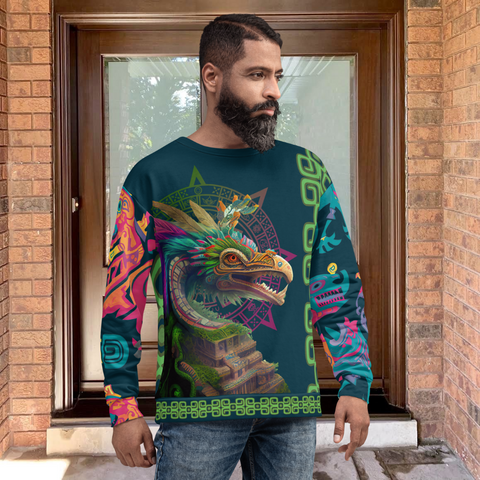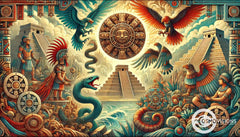Unlocking the Enigmatic World of Aztec Symbols and Meanings
Posted by Massimiliano Geraci

Have you ever looked at an Aztec painting or sculpture and wondered what the symbols mean? Many people find these ancient designs both fascinating and mysterious. The Aztec civilization was full of rich stories, gods, and meanings tied to every symbol—each one a piece of a larger puzzle that defined their world.
One interesting fact about the Aztecs is that they placed huge importance on jaguars, viewing them as powerful creatures linked to war and protection. This blog post will guide you through the complex yet intriguing world of Aztec symbols.
We’ll explore the significance behind animals like the jaguar and natural elements and even delve into the gods themselves—like Xochipilli, who represented art and beauty. Are you ready to learn something amazing?
Key Takeaways
1. Aztec symbols carry deep meanings connected to gods, nature, and society. For example, the jaguar symbolizes war and protection.
2. The Aztec calendar mixes a 260-day spiritual schedule and a 365-day solar one. It shows how time was important to their culture.
3. Animals like monkeys and dogs were not just pets but represented gods and held significant cultural beliefs such as creativity or guidance after death.
4. Nature elements like flowers and rain were sacred in Aztec life. They stood for growth, renewal, and hope.
5. Artists today still use Aztec symbols in their work. These designs help keep the ancient culture alive in modern times.
The Most Significant Aztec Symbols
The Aztec calendar is one key symbol that catches many people’s attention. It combines a 260-day spiritual schedule with a 365-day solar one, marking time uniquely unique to the ancient Mexica culture.
Every 52 years, these calendars aligned in a grand event celebrating the cycle of life. This system wasn’t just for tracking days; it was deeply woven into their society, guiding farming and religious events.
Another famous symbol is the eagle warrior, representing strength and bravery. These elite fighters were central to Aztec warfare and religion. Like the jaguar knight stood for night forces and mystery, the eagle spoke of daylight and vision.
For those living in Tenochtitlan – the heart of modern Mexico – these important symbols were more than art; they carried meanings tied to survival, belief, and identity within an empire that left its mark through symbols still studied today.
Animal Symbols and Their Meanings
Aztec culture was rich in symbolism, with animals playing crucial roles in their religious and societal beliefs. These animal symbols, often depicted as ancient symbols, held deep meanings and were integral to their spiritual and cultural narratives. The monkey, known as Ozomahtli, held special significance as it symbolized the god Xochipili.
Xochipili stands for art, games, beauty, dance, flowers, and song—joyful aspects of life that were vital to Aztec society. Monkeys were, therefore, seen as carriers of creativity and joy. Every animal carries a world of meaning. Itzcuintli, or the dog, represented something entirely different but equally important. Dogs were linked to Mictlantecuhtli, the god who presided over the underworld. This association made dogs symbolize guidance and protection in journeys after death.
Similarly profound meanings attached to other animals like the eagle (Cuauhtli) and jaguar (Ocelotl). Eagles stood for warriors under goddess Xipe Totec’s watchful eye while Jaguars bore Tezcatlipoca’s mightiness into battles against darkness.
Each creature painted vivid pictures across the tapestry of Aztec mythos—stories that guided individuals from birth through death into life beyond this realm with every step marked by an animal ally or protector.
Nature Symbols and Their Meanings
Nature held a sacred place in the hearts of the Aztecs in the central Mexican region. Each element told a story or shared wisdom about life and survival. For example, Xochitl, which means flower, was not just seen as a part of nature’s beauty.
It symbolized the goddess Xochiquetzal, representing fertility and feminine power. Flowers reminded the Aztecs of growth and renewal.
Rain played a crucial role as well. Quiahuitl refers to rain and connects deeply with Tonatiuh, their revered sun deity. Rain brought life-giving water to crops like maize, a staple in their diet.
Therefore, it stood for nourishment and sustenance but also for hope that comes after challenging periods—much like rain revives parched earth.
Water had profound significance through Atl, symbolizing both physical sustenance and spiritual cleansing. It connected them with Xiuhtecuhtli, the god of fire, which balances the elements.
Waterways such as rivers were viewed as paths leading towards greater understanding and connection with gods.
The choices of these symbols—the crocodile (Cipactli) and snake (Coatl)—reveal an intricate web where nature intersects divinity. They show how all living things are intertwined under the watchful eyes of the deities they worshiped, from towering temples down to the tiniest grains of sand beneath their feet.
Symbols of Aztec Deities
Aztec gods had special signs to show who they were. The god Quetzalcoatl, depicted as a feathered serpent, was a significant deity in Aztec culture, known for introducing maize, books, and calendars to mankind. Each sign tells a story about the god’s power and world.
Xochipilli: The God of Art, Games, Beauty, Dance, Flowers, and Song
Xochipilli rules over creativity and joy. His symbols fill art and sacred practices with meaning. They link him to Ozomahtli, the monkey, showing his playful side. He loves all things beautiful - from music to blossoms in bloom.
On his day, people celebrate with festivals full of color and sound.
This deity guides artists and thinkers in their work. Seeing Xochipilli's symbols reminds us of the importance of happiness and creativity in our lives. His presence is felt in every dance step, song note, and brush stroke that aims to make our world a bit brighter.

Supplementary Insights on Aztec Symbols
To truly grasp the depth of Aztec symbolism, we explore their place in society and unfold the stories woven into ancient codices. These pages hold keys to understanding an entire civilization’s way of life, beliefs, and artistry.
Look closer to see more.
The Role of Symbols in Aztec Society
Symbols touched every part of life in the whole central Mexican region. People used them to share stories, explain natural events, and show who they were in society. For the Aztecs, a symbol was more than just a picture; it was a way to understand the world around them.
The Aztec calendar stone is full of these symbols. It shows days, gods, and beliefs simultaneously.
Symbols also helped people see what might happen in the future. They could tell someone if good or bad luck was coming. Each sign had a unique meaning tied to gods, societal levels, or special times.
This system made symbols a key part of making decisions and celebrating important events among the Aztecs.
Decoding Aztec Codices
Exploring Aztec codices opens doors to ancient tales. These books are rich with drawings of rituals and elite fighters. They shine a light on how the Aztecs saw their world and gods. The codices also depict human sacrifice, highlighting its significance in Aztec culture's religious and historical context.
The Codex Borgia, for example, connects directions with mighty deities.
Writers like Camilla Townsend have dug deep into these manuscripts. In her book Fifth Sun, she shows us Aztec feats in engineering. This dive into codices reveals more than just art; it uncovers a civilization’s heartbeat.
Through these pages, we learn about daily life, beliefs, and the Aztecs’ understanding of time and divinity.
Artistic Representation of Aztec Symbols
Aztec symbols are found in art, such as masks and temple embellishments throughout Mexico City. Artists draw on traditional motifs, such as those in Huichol yarn creations and Navajo sand illustrations.
The Aztec font takes shape from typical Aztec geometry and decor, breathing life into letters with ancient flair.
Creatives at Cosmovisions use AI to craft cultural pieces inspired by Aztec icons. These artworks mirror the rich tapestry of symbols adorned with adobe structures and warrior gear.
Through these modern interpretations, the spirit of Mesoamerican culture vibrates anew in homes around the globe, inviting viewers into a timeless dialogue with the past.

Conclusion
Discovering the rich tapestry of Aztec symbols opens doors to ancient wisdom. From powerful creatures to sacred elements, these signs tell stories of life, belief, and the universe.
Artists capture their essence, breathing life into stone and paint. These symbols connect us with ancestors who valued harmony with nature and the divine. Their legacy inspires and teaches us about a world where every mark speaks of deeper truths.
Visit our dedicated page to discover more about the enchanting world of Xochipilli, the Aztec god of art and festivities.
FAQs
1. What were Aztec symbols?
Aztec symbols were special signs used by the ancient Aztecs in Mexico long ago. They showed important things like their gods, warriors, and everyday life.
2. Why did Aztecs use symbols?
They used them to tell stories, honor their gods, and mark special days on their calendars. Symbols helped them share their beliefs and history.
3. Can you name an important Aztec symbol?
Yes! The eagle was very important. It stood for strength and courage. The Aztecs saw it as a sign from the gods to build their city where they found an eagle sitting on a cactus.
4. Did symbols show up in Aztec art?
Absolutely! These symbols can be seen in drawings, sculptures, and even buildings like temples. They ensured that art was full of meaning.
5. What does the serpent symbol mean?
The serpent was linked to Quetzalcoatl, a god who meant a lot to them—like wisdom and life itself. This connection is still evident in modern-day Mexico, where the Aztec culture thrived from the 14th to 16th centuries.
6. How do we learn about these symbols today?
Experts called archaeologists study old things left behind—like pots or temple ruins—to understand what these symbols meant to the Aztecs.























